In this post I have explained a high current Li-Ion battery charger circuit which can be used for charging any high current, such as 2S3P, 3S2P battery packs. It can be also used for charging other similar high Ah rated Li-ion battery from a car or a truck battery. The idea was requested by Mr. Neil
- Charging a 8800 mAh Li-Ion Pack
- Simplest Solid-State Design Using an Op-Amp (Recommended)
- How it Works
- Calculations for the Design
- How to Setup the above Design
- Using LM338 with Op-Amp
- Circuit Diagram
- PCB Design
- How to Set up the circuit.
- Adding a Constant Current Feature in the above Design
- Simplified Design
- 22.2 V Li-Ion Battery Charger Circuit

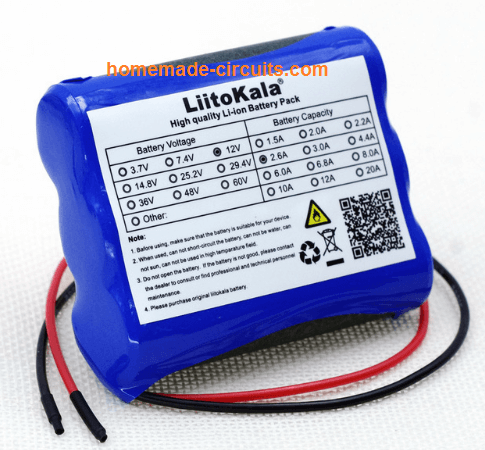
Charging a 8800 mAh Li-Ion Pack
This is perhaps very cheeky of me to ask for your help, but my design skills are limited in electronics and as a volunteer my budget is limited.
I am a volunteer for a local Search and Rescue organisation (Suffolk Lowland Search and Rescue), we are on call 24hrs a day 365 days a year, our work involves finding anyone who has gone missing in Suffolk (and bordering county’s).
Search often take place during the hours of darkness and we have a particular need for good torches, which need to be ready for action at a moments notice.
I am part of the mountain bike rescue team, we cover ground very quickly and can search paths much faster then foot teams, lights are again very important and I hope this is where you can help.
I have recently bought a Cree LED light for my bike, it is powered by a 8.4v Li-ion 8800mAh battery pack, I have 2.
These units came with a mains powered charger (240v UK) and what I would like is to be able to charge them in the car where the bike is kept.
I noticed you have already designed some charging circuits for this type of battery and I wonder if you could modify your design to be able to charge from a 12v car circuit to these specification batteries.
The car circuit will be switched with the ignition. I am very capable of constructing the circuit, it’s just my design skills that are limited!
I very much appreciate anytime you spend on this, it will help not only me, but potentially any lost sole in Suffolk.
Kindest regards,
Neil.
Simplest Solid-State Design Using an Op-Amp (Recommended)
The following circuit of a high current Li-Ion battery charger circuit can be efficiently used for charging all types of Li-Ion and Li-Po batteries, safely. Because this design, despite being simple, includes a constant current feature and also an automatic cut-off feature.
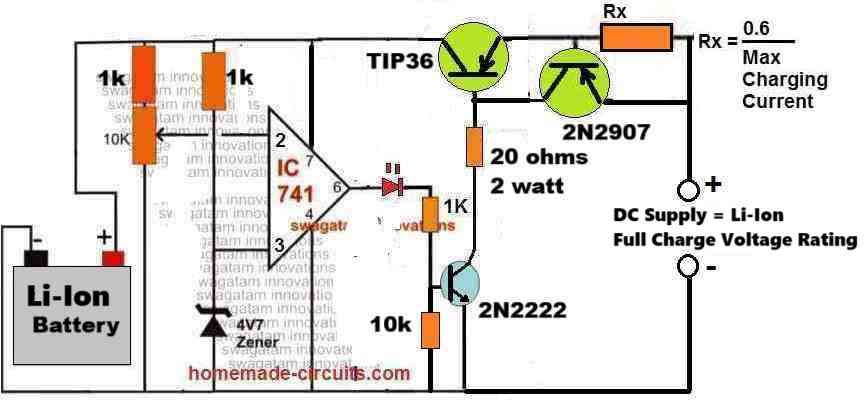
How it Works
Initial Charging Phase:
When the battery is connected and its voltage is below the full-charge level, the IC741 comparators output is high.
This activates the TIP36 allowing current to flow into the battery through Rx.
The charging current is controlled by Rx to prevent overheating or damage to the battery.
Current Limitation:
The value of Rx determines the maximum current delivered to the battery. This prevents overcurrent and ensures safe charging.
Voltage Monitoring:
As the battery voltage rises and approaches the full charge threshold then the non-inverting input (pin 3) of the IC741 exceeds the reference voltage at the inverting input (pin 2).
This causes the IC741 output to switch low turning off TIP36 and stopping the charging process.
Automatic Cutoff:
When the charging stops, the battery is protected from overcharging. The circuit automatically resumes charging if the battery voltage drops below the threshold.
Calculations for the Design
Selection of Rx (Current Control Resistor):
The resistor Rx limits the charging current Imax as per the formula:
Rx = 0.6 / Imax
For example:
If Imax = 1A:
Rx = 0.6 / 1 = 0.6 Ohms
Ensure the power rating of Rx is sufficient to handle the current:
P = Imax2 * Rx
For Imax = 1A and Rx = 0.6 Ohms:
P = 12 * 0.6 = 0.6 W
Use a resistor with a power rating slightly higher than the calculated value (e.g 1W or 2W).
TIP36 Base Resistor
The base resistor ensures sufficient base current for TIP36:
Ibase = Ic / hFE
Where:
- Ibase = Base current
- Ic = Collector current (equal to Imax)
- hFE = Current gain of TIP36 (typically it is around 30)
For example, lets say if the required collector current Imax = 3A:
Then base current Ibase = 3 / 30 = 0.1 A (100mA)
Then we can calculate the base resistor value as:
Rb = (Vout - Vbe) / Ibase
Where:
- Vout = Output voltage of IC741 (approx. 11V)
- Vbe = Base-emitter voltage of TIP36 (approx. 0.7V)
Rb = (11 - 0.7) / 0.1
Rb = 10.3 / 0.1
Rb = 103 Ohms
How to Setup the above Design
First make sure the wiper of the 10K preset resistor is pointing down towards the ground. After that, you need to add a sample voltage from the BATTERY SIDE.
It's really important that this voltage comes from the battery side and not the transistor side. But remember don’t connect an actual battery while you’re testing.
The sample voltage should be a little higher than what the battery's full charge level is. When you do this you should see the LED light up really bright.
Then slowly turn the 10K preset until the LED goes out completely. Once that’s done you can disconnect the power supply and hook up a dead battery. You’ll see the red LED turn on.
Next connect the right amount of full charge voltage from the transistor side to start charging the battery.
When the battery hits the set cut-off point for charging, the red LED will turn off which means the battery is fully charged, and is cut-off from the charging supply.
Using LM338 with Op-Amp
The shown high current Li-Ion battery charger circuit is featured to charge any Li-ion battery upto 5 AH with the shown IC2, or for 10AH batteries if IC2 is appropriately replaced with a LM396
The LM338 IC2 is a versatile voltage regulator IC which can be specifically configured for charging Li-Ion cells with the essential features such constant current and constant voltage.
The above design is configured as a constant voltage Li-ion charger, since we assume that the input supply to be a constant current.
However in case the input supply is not current limited, the IC2 can be enhanced with an effective constant current feature. We will discuss this at the end of this explanation.
The design consists of two fundamental stages, the IC2 voltage regulator stage and the IC1 over charge cut-off stage.
IC2 is configured in its standard voltage regulator form, where P1 functions as the control knob and can be adjusted to generate the required charging voltage across the connected Li-ion battery at the output.
IC1 pin3 is the sensing input of the IC and is terminated with a preset P2 for facilitating the over charge voltage level adjustment.
The preset P2 is adjusted such that when the battery reaches its full charge value, the voltage at pin3 just becomes higher than pin2, resulting in an instant high at pin6 of the IC.
Once this happens the high from pin6 latches on to pin3 with a permanent high via R3, D2, freezing the circuit in that position. Remember this latching network is optional, you can remove it if you wish, but then the the Li-ion battery will not be permanently cut-off, rather intermittently switch ON/OFF depending on the full charge level threshold of the battery.
The above high is also delivered at the base of the BC547 which immediately grounds the ADJ pin of IC2 forcing it to shut down its output voltage thereby cutting off the voltage to the Li-ion battery.
The Red LED now illuminates indicating the full charge level and the cut off conditions of the circuit..
Circuit Diagram
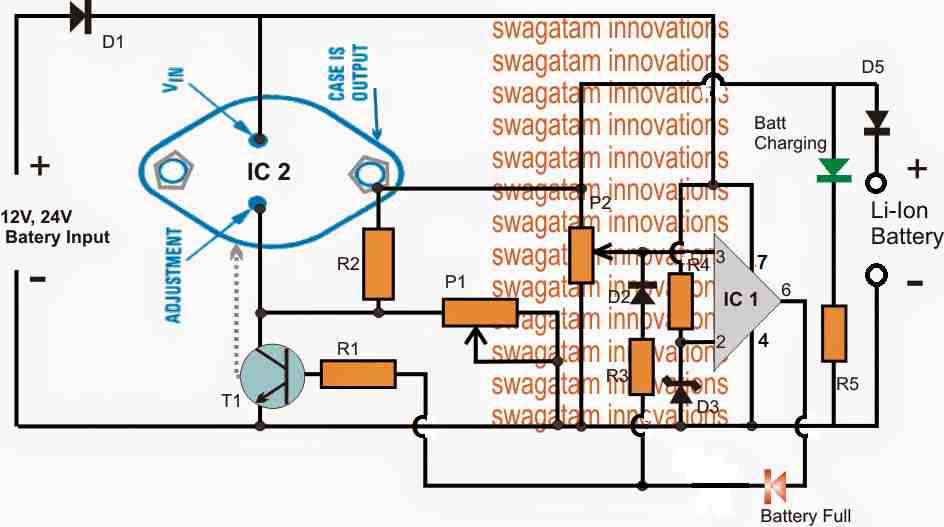
PCB Design
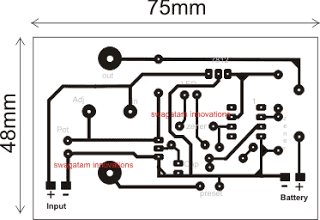
Parts List fro the proposed high current 12V/24V li-ion battery charger circuit
- R1, R5 = 4K7
- R2 = 240 Ohms
- P1, P2 = 10 K Presets
- R3, R4 = 10K
- D1, D5 = 6A4 diode
- D2 = 1N4148
- D3, D4 = 4.7Vzener diode 1/2 watt
- IC1 = 741 opamp for 12V input, LM321 for 24V input
- IC2 = LM338
How to Set up the circuit.
- Initially do not connect any battery at the output, and rotate P2 so that its slider touches the ground end, in other words adjust P2 to make pin3 to zero or ground level.
- Feed the input voltage, adjust P1 for getting the required level of voltage across the output where the battery is supposed to be connected, the green LED will be lit up in this position.
- Now very carefully move P2 upwards until the the red LED just illuminates and latches in that position, stop moving P2 any further, confirm with green LED shutting of in response to red LED illumination.
- The circuit is set now for the required high current Li-ion charging from a car battery or any 12/24V source..
Adding a Constant Current Feature in the above Design
As shown below, the above design can be further improved by adding a current control feature, which makes the proposed high current Li-ion charger circuit perfect with the features of CC, and CV, that is with constant voltage and constant current attributes.
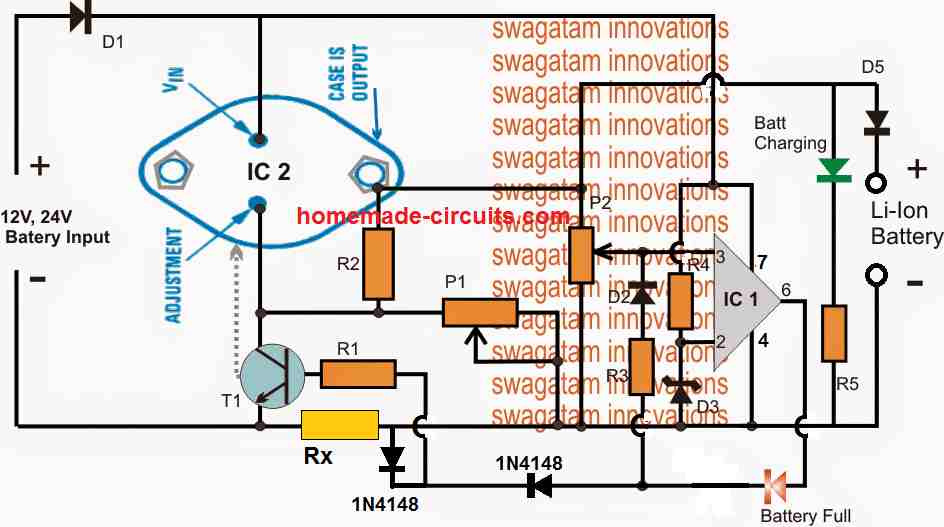
Note: The latching of the op amp is not compulsory, hence the D2 and R3 can be removed, and the circuit will still work nicely and automatically cut-off when the battery is fully charged.
Simplified Design
While the above explained circuits are great with their features and working, the use of LM338 makes the design a bit complex, and costly.
A little tinkering reveals that the application could rather be implemented using only a single opamp and a BJT based current control as shown below:
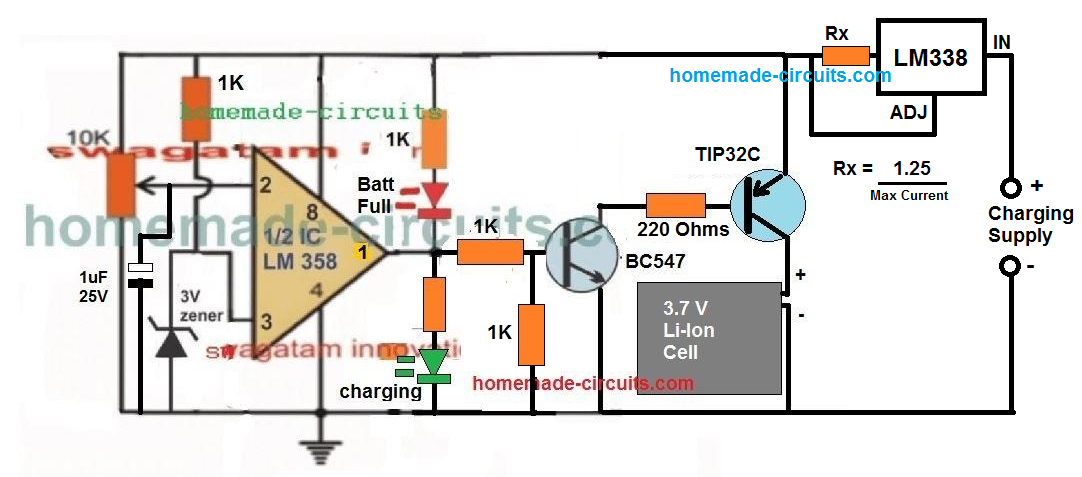
A 1uF capacitor is introduced at the inverting input of the IC, which ensures that the IC always starts with its output at positive high when powered. This in turn allows a guaranteed switch ON of the output transistor, and enables the connected battery to lock in with the charging process.
The concept has been tested thoroughly, the video proof can be seen here.
22.2 V Li-Ion Battery Charger Circuit
The following diagram shows a simple yet very accurate Li-Ion battery charger circuit with cut off. This charger can be used for charging a 6S Li-Ion battery rated at 22.2V.
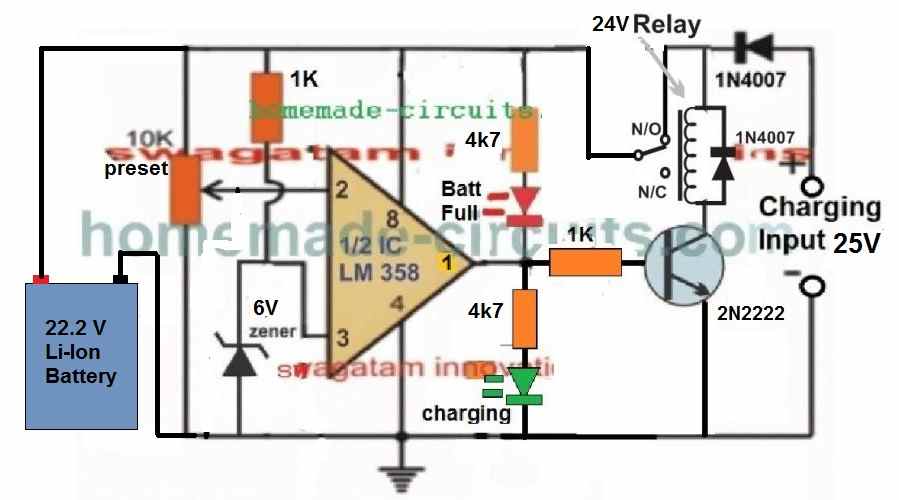
WARNING: IN ALL THE ABOVE CONCEPTS, TEMPERATURE REGULATION FOR THE BATTERY IS NOT INCLUDED, SO PLEASE MAKE SURE TO ADJUST THE CURRENT TO A LEVEL WHICH DOES NOT CAUSE THE BATTERY TEMPERATURE TO REACH ABOVE 40 DEGREES CELSIUS.